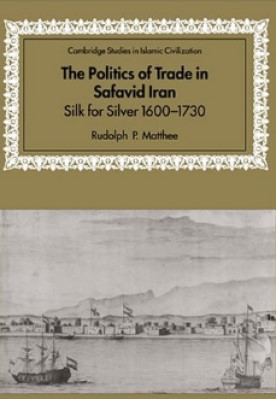The Politics of Trade in Safavid Iran: Silk for Silver, 1600-1730

| The Politics Of Trade In Safavid Iran |
| Rudolph P. Matthee |
| 157 |
| |
| PDF Direct Link |
| Click for Copy from Amazon |
THE POLITICS OF TRADE IN SAFAVID IRAN – Book Sample
About the Book – THE POLITICS OF TRADE IN SAFAVID IRAN
The Politics of Trade in Safavid Iran Silk for Silver, 1600- 1730 Rudolph P. Matthee’s book offers a sophisticated, revisionist interpretation of the economy of Safavid Iran. Using a wide range of archival and written sources in languages ranging from Persian to Dutch and Russian, the author considers the economic, social and political networks established between Iran, its neighbors, and the world at large, through the prism of the late Safavid sillk trade.
In so doing, the author demonstrates how silk, the only commodity which spanned Iran’s entire economic activity, was integral to various aspects of late Safavid society, including its approach to commerce, export routes, and, crucially, to the political and
economic problems which confounded the Safavid state in the early 1700s. In a challenge to traditional schola rs hip, the author argues that, despite the introduction of the maritime, western-dominated channel, Iran’s traditional land-based silk exports continued to expand and diversify right up to the end of the seventeenth century. The book makes a major theoretical contribution to the current debates on the social and economic history of the pre-modern world. R UDOLPH P . MATTHEE is Associate Professor of History at the University of Delaware.
Introduction
Long-distance trade has forever been a quit essential part of life on the Iranian plateau. A crossroads between the Indian subcontinent, Central Asia, Russia, and the Mediterranean basin, Iran was the scene of east-west commerce even before the early days of the fabled Silk Road, an important branch of which traversed the country.
Of the many commodities ferried across Asia, silk was invariably of the most precious. In the West, however, silk has never readily been associated with Iran, not even in the form of the country’s well-known carpets, the most priceless of which have always been made of silk rather than wool. The popular identification of silk with China has obscured the fact that silk did not just pass through Iran but that for many centuries the country was also an important producer of raw silk as well as of silk textiles.
The latter were among the commodities carried to Byzantine textile workshops in the antiquity. Sasaoian silk patteros remained popular in Asia long after the fail of the dynasty in the seventh century. In the Middle Ages raw silk from Gilan and Mazandaran was coveted by Italian merchants who imported it to feed an expanding textile manufacturing industry at home. ln the fifteenth and sixteenth centuries, Iranian silk transported to the Levant provided the raw material for textile manufacturing in the Ottoman city of Bursa.
And in the I600s, Western travelers marveled at the high-quality brocades and taffetas produced by Iran’s workshops, while Dutch and English merchants purchased large quantities of Iranian raw silk to satisfy a growing demand in Amsterdam and London.
Iranian silk long remained embedded in what Marshall Hodgson bas….
called the Afro-Eurasian Oikoumene, the world between the Mediterranean and Central Asia that was knitted together by common cultural pattems and a comprehensive trading network.1 This world was challenged in a process that, though known under different names, can be summed up as the “rise of the West.” Historians differ about the precise timing of this process, but most have placed it in the context of the great maritime
To read more about the The Politics Of Trade In Safavid Iran book Click the download button below to get it for free
Report broken link
Support this Website
 Don't Miss out any Book Click Join OpenMaktaba Telegram group
Don't Miss out any Book Click Join OpenMaktaba Telegram group